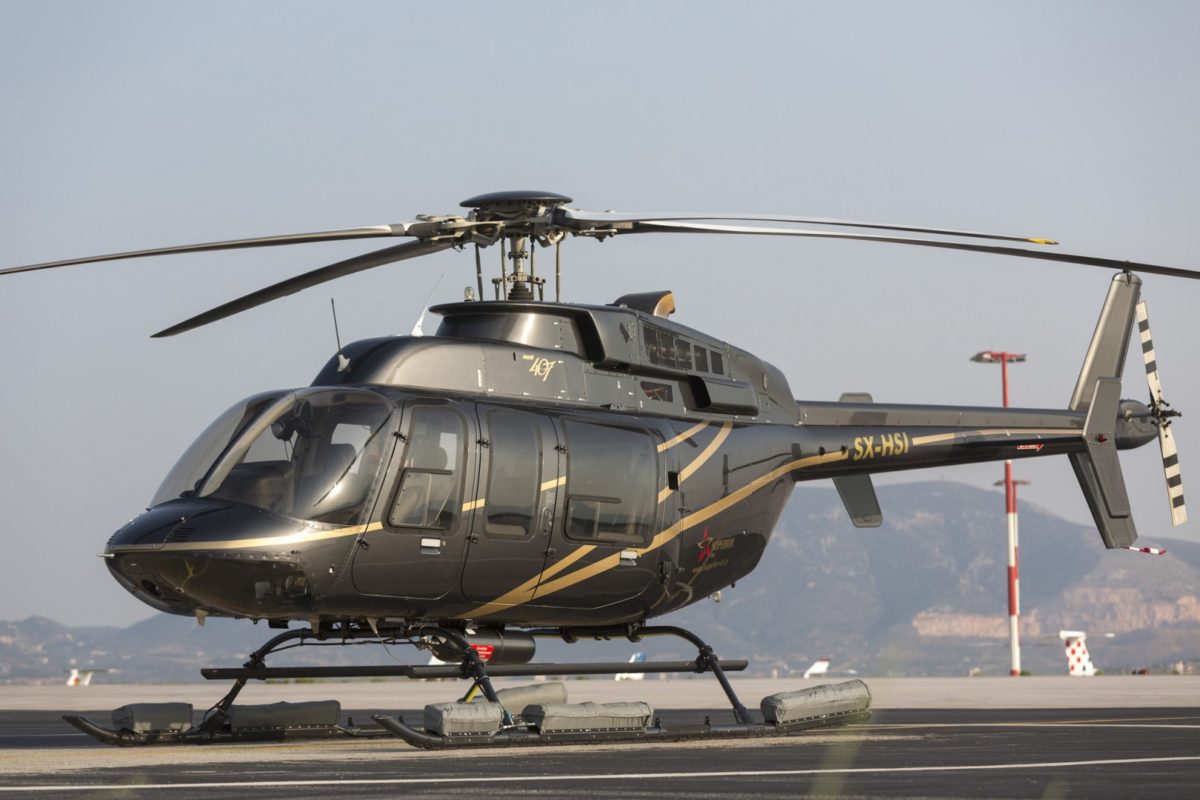The Ottawa-based Canadian Commercial Corporation (CCC) is a federal government agency that facilitates government-to-government contracts to sell Canadian goods and services to countries around the world including military hardware such as helicopters.
Its 2013-14 annual report notes this “success story” in Colombia:
“As per the CCC contract with Ministry of Defense, four Bell 407 helicopters were delivered to the National Police; and two Bell 412 helicopters were delivered to the Naval Aviation Group [the Colombian navy]. The aircraft were manufactured by Bell Helicopter Textron Canada Ltd. of Mirabel, QC,” the report reads.
Open-source research by Peace Brigades International-Canada (PBI) reveals that Bell 407 helicopters were used for surveillance of the Colombian labour movement-organized National Strike mobilization on November 21, 2019.
On November 20, 2019, Colombian weekly news magazine Semana reported that the Bell 407 Halcón (Falcon) helicopter would be used by the National Police to monitor National Strike protests in Bogotá with high resolution cameras with facial recognition technology.
“The aircraft, normally, carries four policemen (two pilots) and sends the images it takes to the police command, in real time, so that they are implemented in chases, padlock operations and all kinds of operations,” Semana noted at the time.
Webinfomil.com further reported that the National Police would “deploy its entire fleet of Bell 407 Halcón surveillance helicopters … in the main cities of the country, where the most important concentrations are expected to occur.”
What was being surveilled?
The National Strike was convened by the Colombian labour movement, including the Unitary Central of Workers (CUT), the General Confederation of Labor (CGT) and the Confederation of Workers of Colombia (CTC).
PBI-Colombia Project accompanied human rights defenders took part in the mobilizations that day.
“Hundreds of thousands of protesters marched through the dense city streets of Bogota and other cities across Colombia,” Al Jazeera reported the following day, November 20, 2019.
“Spokesmen for several organizations backing the protests said more than one million people had marched nationwide,” reads another report from AFP.
Why were so many people on the streets?
“Stopping the killing of environmental and social leaders, stopping deforestation, prohibiting fracking and the use of glyphosate, protecting the moors and respecting popular consultations, are some of the reasons why environmentalists took to the streets to make themselves felt,” Semana Sostenible explained.
How did the Colombian police respond?
By November 23, 2019, José Alvear Restrepo Lawyers’ Collective (CCAJAR) tweeted concerns about the use of force by Colombian authorities.
“News The Colombian authorities must put an end to the repression of social protests and the excessive use of force against those who demonstrate, guaranteeing the human rights of all people: @Amnesty International,” the CCAJAR tweet reads.
#Actualidad Las autoridades colombianas deben poner fin a la represión de las protestas sociales y al uso excesivo de la fuerza en contra de quienes se manifiestan, garantizando los derechos humanos de todas las personas: @amnistia https://t.co/f67mJqXCCZ Amnistía Internacional.
— ColectivoDeAbogad@s (@Ccajar) November 23, 2019
PBI-Colombia echoed CCAJAR’s concerns by with their own statement on Twitter.
“Social and peaceful protest is a human right more than anything else, disproportionate repressions cannot be justified against the civilian population, we request guarantees and respect for life,” reads the PBI-Colombia tweet.
La protesta social y pacífica es un derecho humano más que todo, las represiones desproporcionadas no se pueden justificar en contra de la población civil, solicitamos garantías y respeto a la vida https://t.co/Rx1ZB2rh7B
— PBI Colombia (@PBIColombia) November 23, 2019
The National Strike protests continued into 2021, as have concerns about the actions and impunity of the Colombian national police.
“During Colombia ‘s decades-long conflict with violent rebel groups, the national police often fought on the front lines, using tanks and helicopters to combat guerrillas and destroy drug labs. It was a force made for war, one that has now found a new front, in the streets of Colombian cities, where police have been accused of treating civilian protesters as enemies on the battlefield,” the New York Times reported in May of 2021.
Were the Canadian-made helicopters sold to the Colombian National Police used in the National Strike protests?
“The Ottawa-based CCC [Canadian Commercial Corporation] acknowledges it conducts no follow-up to ensure exported Canadian-built equipment isn’t being used to abuse human rights,” noted Post Media reporter David Pugliese.
As such, the question remains unanswered.
PBI-Colombia accompanied organizations NOMADESC and CREDHOS have made demands that Canada stop assisting the Colombian police with equipment
PBI webinar, May 31
On May 29, 2014, the Canadian Commercial Corporation noted: “At CANSEC 2014, CCC led eight foreign delegations visiting from Argentina, Bahrain, Chile, Colombia, Kuwait, Mexico, Peru, and Saudi Arabia. CCC toured the exhibition floor with these delegations and introduced representatives to new Canadian technologies, facilitating meetings between foreign delegations and Canadian companies.”
The Bell 407 helicopters were sold to Colombia in 2013-14.
On this coming May 31, the day before the Canadian Association of Defence and Security (CANSEC) 2022 trade show, PBI is organizing a webinar on arms exports and militarization of territory.
To register for that, please click here.



